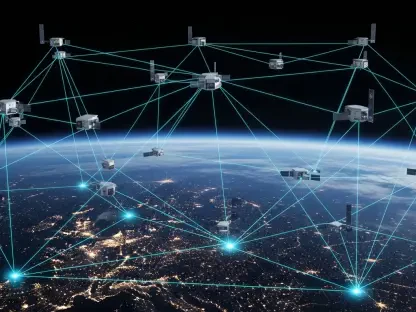In an era where connectivity is the backbone of daily life, the ability to maintain a robust network during unexpected disruptions like hurricanes or massive public events is paramount for telecommunications providers. Imagine a scenario where a severe storm knocks out a critical cell tower, leaving thousands without communication at a time when they need it most. This is where innovative technology steps in to bridge the gap, ensuring that both individuals and emergency responders stay connected. AT&T has introduced a groundbreaking solution that leverages artificial intelligence to tackle such challenges head-on. Known as the Wireless Geo Modeler, this generative AI system is designed to enhance network optimization and planning, offering a lifeline in both routine operations and crisis situations. By harnessing advanced algorithms and real-time data, this tool promises to redefine how network resilience is achieved in the face of dynamic environmental and operational shifts.
Revolutionizing Network Management with AI
Transforming Coverage Predictions
The Wireless Geo Modeler stands out as a pioneering tool in the telecommunications landscape, primarily due to its ability to predict network coverage with remarkable precision. Utilizing a combination of synthetic data, a Network Foundation Model (NFM), and ray tracing, the system simulates radio transmissions across complex geospatial environments. This predictive capability allows for near-instantaneous analysis of potential coverage gaps, even in scenarios where physical infrastructure is compromised. For example, during a natural disaster, if a tower goes offline, the AI can assess the impact within seconds and propose solutions to maintain connectivity. Such rapid response is critical for ensuring that customers and first responders remain linked to vital services, highlighting the transformative power of AI in preempting network failures before they escalate into larger issues.
Automating Real-Time Adjustments
Beyond prediction, the Geo Modeler excels in automating network adjustments to address disruptions as they occur. When a coverage issue is detected, the system can recommend specific actions, such as tweaking antenna angles on nearby towers to compensate for lost signals. These automated suggestions are not implemented in isolation; they are closely monitored by AT&T staff to ensure accuracy and reliability. This blend of AI efficiency with human oversight creates a robust framework for maintaining service quality under varying conditions. Whether it’s a sudden surge in demand during a major event or a seasonal change affecting signal propagation, the technology adapts configurations in near real-time. This dynamic approach minimizes downtime and enhances user experience, setting a new standard for how networks can self-correct and remain operational in challenging circumstances.
Enhancing Resilience for Diverse Scenarios
Adapting to Environmental and Event-Based Challenges
One of the standout features of the Wireless Geo Modeler is its versatility in handling a wide array of environmental and situational challenges. From seasonal shifts that alter signal strength to large-scale public gatherings requiring boosted capacity, the system adjusts network parameters to meet fluctuating demands. This adaptability ensures that connectivity remains stable, whether in rural areas affected by foliage changes or urban centers hosting major events. By analyzing historical data and real-time inputs, the AI identifies patterns and anticipates needs, allocating resources precisely where they are most critical. Such proactive management not only improves daily operations but also prepares the network for unexpected spikes in usage, ensuring that performance remains consistent across diverse contexts and preventing potential service interruptions.
Supporting Emergency Operations with Emerging Tech
Equally significant is the Geo Modeler’s role in bolstering emergency response capabilities through integration with emerging technologies like drones. During crises, first responders often rely on drones for situational awareness, requiring strong and reliable connectivity for effective operation. The AI system calculates optimal flight paths and elevations to maintain signal quality, ensuring seamless communication in high-stakes environments. This functionality underscores a broader movement toward network autonomy, where AI-driven solutions enable rapid, self-healing responses to maintain uptime. By supporting critical communications in disaster zones, the technology not only aids public safety but also demonstrates how telecommunications can evolve to meet the urgent needs of modern emergency services, reinforcing trust in network dependability during the most trying times.
Paving the Way for Future Innovations
Setting a Benchmark in Service Assurance
Reflecting on the impact of the Wireless Geo Modeler, it’s clear that this AI-driven system marks a significant milestone in telecommunications by enhancing service assurance. Industry experts, including analysts like Will Townsend from Moor Insights & Strategy, praise its ability to provide near real-time network predictions, particularly during natural disasters. This capability ensures that disruptions are addressed swiftly, maintaining connectivity when it matters most. The visibility and dynamic uptime facilitation offered by the system have become a benchmark for the industry, illustrating how predictive modeling and automation can transform network reliability. Its nationwide deployment solidifies AT&T’s commitment to dependable service, setting a precedent for how technology can uphold public safety and customer satisfaction in the face of adversity.
Looking Ahead to Broader Industry Implications
As the industry continues to evolve, the legacy of the Geo Modeler points to exciting possibilities for future advancements. The system has laid the groundwork for innovations such as AI-powered APIs for connected cars, hinting at broader applications beyond traditional network management. Telecommunications providers can build on this foundation by integrating similar AI tools to address emerging connectivity demands. Exploring partnerships with tech developers to create adaptive solutions for smart cities or IoT ecosystems could further enhance network resilience. Additionally, investing in research to refine predictive models will ensure networks remain robust against increasingly complex challenges. This forward-thinking approach, inspired by past successes, promises to drive the industry toward greater efficiency and reliability, ensuring that connectivity remains a steadfast pillar of modern life.









